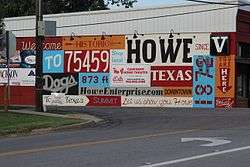Howe, Texas
| Howe, Texas | |
|---|---|
| Town | |
|
Downtown Howe, Texas | |
|
Location of Howe, Texas | |
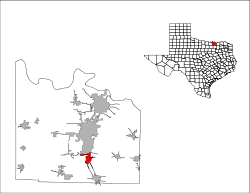 | |
| Coordinates: 33°30′18″N 96°36′51″W / 33.50500°N 96.61417°WCoordinates: 33°30′18″N 96°36′51″W / 33.50500°N 96.61417°W | |
| Country | United States |
| State | Texas |
| County | Grayson |
| Government | |
| • Mayor | Jeff Stanley |
| • City Administrator | Joe Shephard |
| Area | |
| • Town | 3.9 sq mi (10.0 km2) |
| • Land | 3.9 sq mi (10.0 km2) |
| • Water | 0.0 sq mi (0.0 km2) |
| • Metro | 979 sq mi (2,536 km2) |
| Elevation | 840 ft (256 m) |
| Population (2010)The data for Howe, TX may also contain data for the following areas: Dorchester | |
| • Town | 2,798 |
| • Density | 641.2/sq mi (247.6/km2) |
| • Metro | 120,877 |
| • Metro density | 130/sq mi (50/km2) |
| Time zone | Central (CST) (UTC-6) |
| • Summer (DST) | CDT (UTC-5) |
| ZIP code | 75459 |
| Area code(s) | 903 |
| FIPS code | 48-35084[2] |
| GNIS feature ID | 1359742[3] |
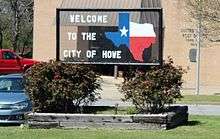
.jpg)
Howe is a town in Grayson County, Texas, United States. The population was 3,279 at the 2010 census. It is part of the Sherman–Denison Metropolitan Statistical Area
History

Howe is at the intersection of U.S. Highway 75, State Highway 5, and Farm Road 902, on the Southern Pacific line ten miles south of Sherman in southern Grayson County. The first settlers in the area arrived around the time of the Texas Revolution in 1836. In 1843, it is said, the last Indian battle in Grayson County was fought in the area. The first settlers of Howe were Jabez and Harriet Haning and Jabez's brother John. They received land through the Peters colony after their arrival from Pennsylvania before 1850. The Houston and Texas Central Railway built through the area in 1873, and a railroad switch was located in the community. It was called Summit because at 810 feet above sea level it was supposed to be the highest point between the Red River and the Gulf of Mexico. In 1873, when Summit received a post office, two businesses were located at the switch: a general store and a saloon. Several houses were built to the east of the switch. Jabez Haning persuaded the railroad to establish a depot on his land by donating every second lot in his newly platted town to the railroad. The name of the depot, the store, and the post office was changed in 1876 to Howe, after F. M. Howe, who worked for the Houston and Texas Central. Howe had three saloons until around 1900, when the town voted to go dry. Its first one-room school building opened in 1877 and was replaced by a two-story building in 1884.
In 1884, Howe was incorporated, with George M. McCrary as mayor. By the late 1880s the town had become a major grain-shipping center and was the home of Red Rust-proof Oats. A number of seed companies had their beginnings there in that decade. Howe became home to a Farmers' Alliance Cooperative Association, which was absorbed by the Howe Grain and Mercantile Company in 1894. In 1890 Howe had a population of 450, a steam gristmill, a Farmers' Alliance Cooperative, and Baptist and Methodist churches, as well as a number of hotels, doctors, druggists, and barbers. Several newspapers were published in Howe, such as the Howe Herald from 1890-1910s and the Howe Messenger in the late 1930s and early 40s. During the 1930s the Howe Chronicle was published by former Governor James E. Ferguson and his brother A. M. Ferguson. The Howe Enterprise was established in 1963 by A.P. "Pop" Sloan. By 1914 the Texas Traction Company, better known as the Interurban, was providing service to Howe. This electric train ran between Denison and Dallas with a stop in Howe. By 1914 Howe also had the Farmers National Bank, the Howe Herald, three grain elevators, and an ice plant. The community's population had grown from 521 in 1904 to 680 in the early 1960s. After that it rose rapidly through the early 1980s, reaching 2,173 by 1990. By 2000 the population was 2,478. Throughout most of its history Howe remained primarily an agricultural center, some oil has been produced in the area. During the early 1980s Howe reported some thirty businesses. In 1981 local industries included a shirt manufacturer and a hydraulics company, and by 1991 the number of manufacturers at Howe had risen to five, including makers of plastics, electronics, and agricultural equipment. As of 2016, Howe has no grocery store.
Geography
Howe is located at 33°30′18″N 96°36′51″W / 33.50500°N 96.61417°W (33.505089, -96.614239).[4]
According to the United States Census Bureau, the town has a total area of 3.9 square miles (10 km2), all of it land.
Howe's elevation is the highest point between the Red River and the Gulf of Mexico.
Demographics
| Historical population | |||
|---|---|---|---|
| Census | Pop. | %± | |
| 1890 | 284 | — | |
| 1900 | 531 | 87.0% | |
| 1910 | 581 | 9.4% | |
| 1920 | 583 | 0.3% | |
| 1930 | 565 | −3.1% | |
| 1940 | 546 | −3.4% | |
| 1950 | 572 | 4.8% | |
| 1960 | 680 | 18.9% | |
| 1970 | 1,359 | 99.9% | |
| 1980 | 2,072 | 52.5% | |
| 1990 | 2,173 | 4.9% | |
| 2000 | 2,478 | 14.0% | |
| 2010 | 2,600 | 4.9% | |
| Est. 2015 | 2,798 | [5] | 7.6% |
At the 2000 census,[2] there were 2,478 people, 924 households and 693 families residing in the town. The population density was 641.2 per square mile (247.9/km²). There were 997 housing units at an average density of 258.0 per square mile (99.7/km²). The racial makeup of the town was 94.87% White, 0.52% African American, 0.52% Native American, 0.12% Asian, 0.08% Pacific Islander, 2.10% from other races, and 1.78% from two or more races. Hispanic or Latino of any race were 4.56% of the population.
There were 924 households of which 44.5% had children under the age of 18 living with them, 56.5% were married couples living together, 15.4% had a female householder with no husband present, and 25.0% were non-families. 21.4% of all households were made up of individuals and 9.1% had someone living alone who was 65 years of age or older. The average household size was 2.68 and the average family size was 3.14.
31.9% of the population were under the age of 18, 9.3% from 18 to 24, 32.1% from 25 to 44, 17.8% from 45 to 64, and 8.9% who were 65 years of age or older. The median age was 31 years. For every 100 females there were 89.6 males. For every 100 females age 18 and over, there were 83.6 males.
The median household income was $34,963, and the median family income was $41,125. Males had a median income of $34,625 versus $22,829 for females. The per capita income for the town was $15,664. About 9.9% of families and 12.4% of the population were below the poverty line, including 12.4% of those under age 18 and 20.9% of those age 65 or over.
Traditions
Victory Light
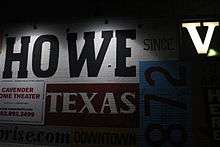
Howe's Victory Light is turned on immediately following each varsity Howe Bulldogs win during the regular season and playoffs. The light remains lit for the entire week leading up to the following week's Thursday games. It is turned off on Thursdays before games are played. The tradition began in 1977 by Bulldogs' Head Coach James "Blackie" Wade. It was formed by two simple light strips attached together with 19 light bulbs and was placed on the back of Bulldog Stadium's press box. The tradition was interrupted after the 1991 season when the "V" was replaced with a light box with the Bulldogs logo. The light box was never used as a victory light and would even be lit after losses. However, in 2007, the panel finally cracked and a V was replaced in 2008 and the tradition was fully restored. In 2014, Howe ISD constructed a new press box and the Victory Light was donated to an alumni who hung the light at the four-way stop in the historic downtown district of Howe. The light which once was attached to a simple breaker in the press box is now controlled remotely and can be turned on immediately from a smart phone device from an out of town game. In 2015, the light was turned on 10 of 12 weeks, which is the most since its inception.
Founders Day
.jpg)
Howe celebrates its history and origins every May with a Founders Day celebration. The first Founders Day was in 1986 and featured a Pro Rodeo along with many festival events. Each year, vendors line up in the downtown parking spaces with items for sale. The festival features food, shaved ice, bounce houses, and things you would expect from a small town festival. It is a product of the Howe Area Chamber of Commerce. The city will celebrate the 30th Anniversary of Founders Day in on May 7, 2016 from 2pm - 8pm with live music the majority of the evening. There will also be dance performances, lawnmower race, horseshoe tournament and a Touch a Truck event.
Education
Public schools
The City of Howe is served by the Howe Independent School District and home to the Howe High School Bulldogs.
Colleges and Universities
Grayson College operates a branch campus six miles to the south.
Austin College, a private, Presbyterian, liberal arts college, relocated to Sherman in 1876. Founded in 1849, it is the oldest college or university in Texas operating under its original charter.
Media
Newspaper
Radio stations
- KLAK Adult Contemporary 97.5
- KMAD Mad Rock 102.5
- KMKT Katy Country 93.1
- KDOC Doc FM 107.3
Television stations
- KTEN Channel 10 - (NBC)
- KTEN DT Channel 10.2 - (The CW Texoma)
- KTEN DT Channel 10.3 - (ABC)
- KXII Channel 12 - (CBS)
- KXII DT Channel 12.2 (My Texoma)
- KXII DT Channel 12.3 (Fox Texoma)
Notable People of Howe
Mame Roberts
.jpg)
Mame Roberts (August 19, 1883 - December 24, 1976) in Howe, Texas. The daughter of James M. and Martha Sue (Baxter) Roberts, Mame Roberts lived her entire life in or near the community of Howe. Largely self-taught, she worked as a substitute teacher in the lower grades at the Howe public schools in the early 1900s before turning to her life's work-promoting civic improvements and beautification. As the writer of a weekly column in the Howe Messenger, Mame Roberts promoted her hometown and encouraged its beautification. Her campaign to make Howe the "Prettiest Little Town in Texas" motivated other small Texas towns to take similar action. A series of articles in the Dallas Morning News provided step-by-step instructions for carrying out beautification efforts, and she was in great demand as a speaker at garden club gatherings throughout this part of the state. Mame's work attracted the attention of Life magazine and Reader's Digest, and she was named "Woman of the Day" on May 14, 1949, on Eleanor and Anna Roosevelt's National Radio Program. Her leadership positions included: President of the Grayson County Federation of Women's Club; President of the Texoma Redbud Association, which urged the planting of Redbuds along highways in Texas and Oklahoma; and founder and president of the Howe Sesame Club. Her work, which spanned the decades before and after World War II, is a significant part of the civic history of Howe and of all the towns that put her lessons into action.
Jabez Haning
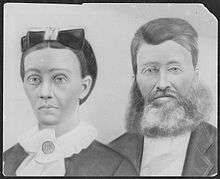
Jabez Haning (1827-1883) came to Grayson County with his family in 1846. In the 1850s Jabez Haning obtained a grant of 320 acres (130 ha) of land from the Peters Colony. His land was located about nine miles south of the town of Sherman. Harriet Campbell (1834-1880) and Jabez Haning were married in 1854 and established a farm. In 1873 the Houston & Texas Central Railway established a line south of Sherman. The route went through the Haning property, and they donated land for a town site in 1876. The town was named Howe, in honor of a railroad official.
A.M. Ferguson
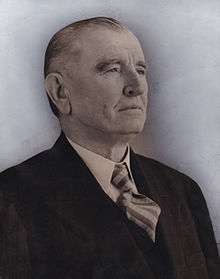
Alexander McGowan Ferguson (1874-1955), a professor at the University of Texas wrote a book called Elementary Principals of Agriculture which became the accepted textbook in public schools in 30 states for 12 years. He moved his company called Ferguson Seed Farms to Howe in 1931 and shipped between 70 and 100 cars of seed daily by train. Howe was known as the seed capital of Texas. The former seed farm was located at the location of A.M. Ferguson Park (named in his honor), which the land was donated to the city by the Ferguson family for strict use of a city park.
L.B. Kirby
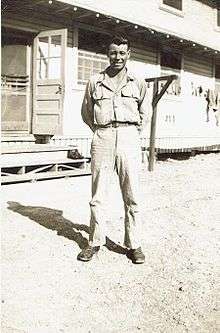
L.B. Kirby (1924- ) is the most decorated living veteran in the state of Texas, with seven Bronze Stars,two Bronze Arrowheads and a Purple Heart, awarded for his service in the army during World War II. Perhaps the most surprising thing about Kirby's heroic achievements is that for decades, he never told anyone about his awards, including his family. A 1943 graduate of Howe High School, Kirby entered the military just 15 days after finishing high school. Kirby trained as a fire operator and served as a machine gunner under General Douglas MacArthur in the First Cavalry Division of the United States Army and was hit in the back by shrapnel from a Japanese rocket. He spent three months in a field hospital recovering. He rejoined his unit preparing for an invasion of Japan by the Japanese who surrendered on Aug. 15, 1945. Kirby was one of only 25 men left out of his unit of 250.
Elmer Schenk
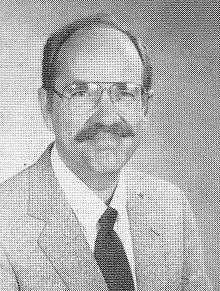
Elmer Schenk (1949 - ) was hired as Howe High School's second ever band director in 1977. As early as 1979, Schenk had taken a fairly new band program and turned it in to one of the most surprisingly talented marching bands in the region. By 1980, he made them the best in Texas. With a demand for perfection, his bands received over 20 Sweepstakes Awards (first division in Marching, Concert, and SightReading) and was named the Class 2A TMEA Honor Band in 1986 and 2000 and was a top five finalist three other years. His band won the UIL State Marching contest in 1980, 1995 and 1997 and was a finalist multiple other times. He is also a founding charter member of the Association of Texas Small School Bands which is an organization that has brought immeasurable recognition and opportunities for smaller school bands and their students since 1992. Though retired, he continues to mentor band directors in the area and work with band students through substitute teaching and the volunteering of his time to work with band directors and their students.
Norman Bennett
Norman Bennett is an actor, known for Terms of Endearment (1983), Tender Mercies (1983) and Hope Floats (1998). His extensive list of movie appearances can be found at imbd.com. He was a math teacher at Howe High School from 1971-1991 and is often referred by his students to be one of the best teachers in Howe's history. His 1991 student assembly story of a foreign exchange student's pronunciation of pi (3.14) has become legend in Howe. Texas.
References
- ↑ http://howeenterprise.com/wp-content/uploads/2014/08/Volume-1-Edition-2.pdf
- 1 2 "American FactFinder". United States Census Bureau. Retrieved 2008-01-31.
- ↑ "US Board on Geographic Names". United States Geological Survey. 2007-10-25. Retrieved 2008-01-31.
- ↑ "US Gazetteer files: 2010, 2000, and 1990". United States Census Bureau. 2011-02-12. Retrieved 2011-04-23.
- ↑ "Annual Estimates of the Resident Population for Incorporated Places: April 1, 2010 to July 1, 2015". Retrieved July 2, 2016.
- ↑ "Census of Population and Housing". Census.gov. Retrieved June 4, 2015.
External links
- City of Howe official website
- Howe Development Alliance
- Howe Area of Commerce
- Howe Independent School District
- Texas State Historical Association
